|
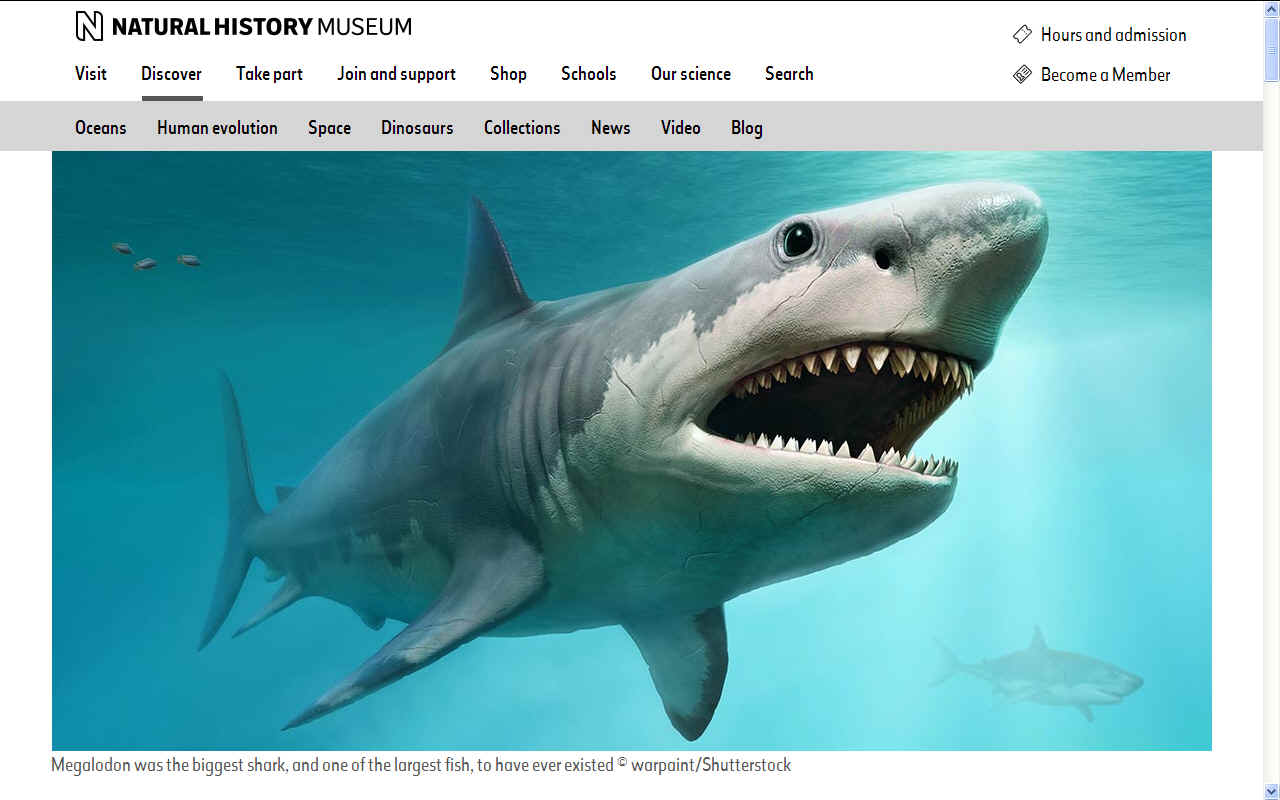
DENTAL -
The megalodon has the largest teeth of any shark. Although the largest teeth from megalodon are a little over 7 inches, A more common size for megalodon teeth is between 3 and 5 inches. The image shows one of the worlds largest megalodon teeth. It s 7 1/4" (184 mm) slant height and was found by Vito Bertucci in South Carolina.
The
Cleaner Ocean Foundation are looking at the possibility of creating one
of the most exciting displays in the world as a natural showcase for exhibition
on land and to give ocean rides to shark enthusiasts.
The
idea is to create the largest interactive animatronic megalodon in the world.
The difficulty being not only raising the funding, but also agreeing on
what the huge fish should look like.
We
drew some inspiration from the recent film starring Jason
Statham, though the CGI shark is probably not as accurate as most
marine biologists might like, it's not a bad effort - and we liked the
film - yes, and we are Jason fans of course.
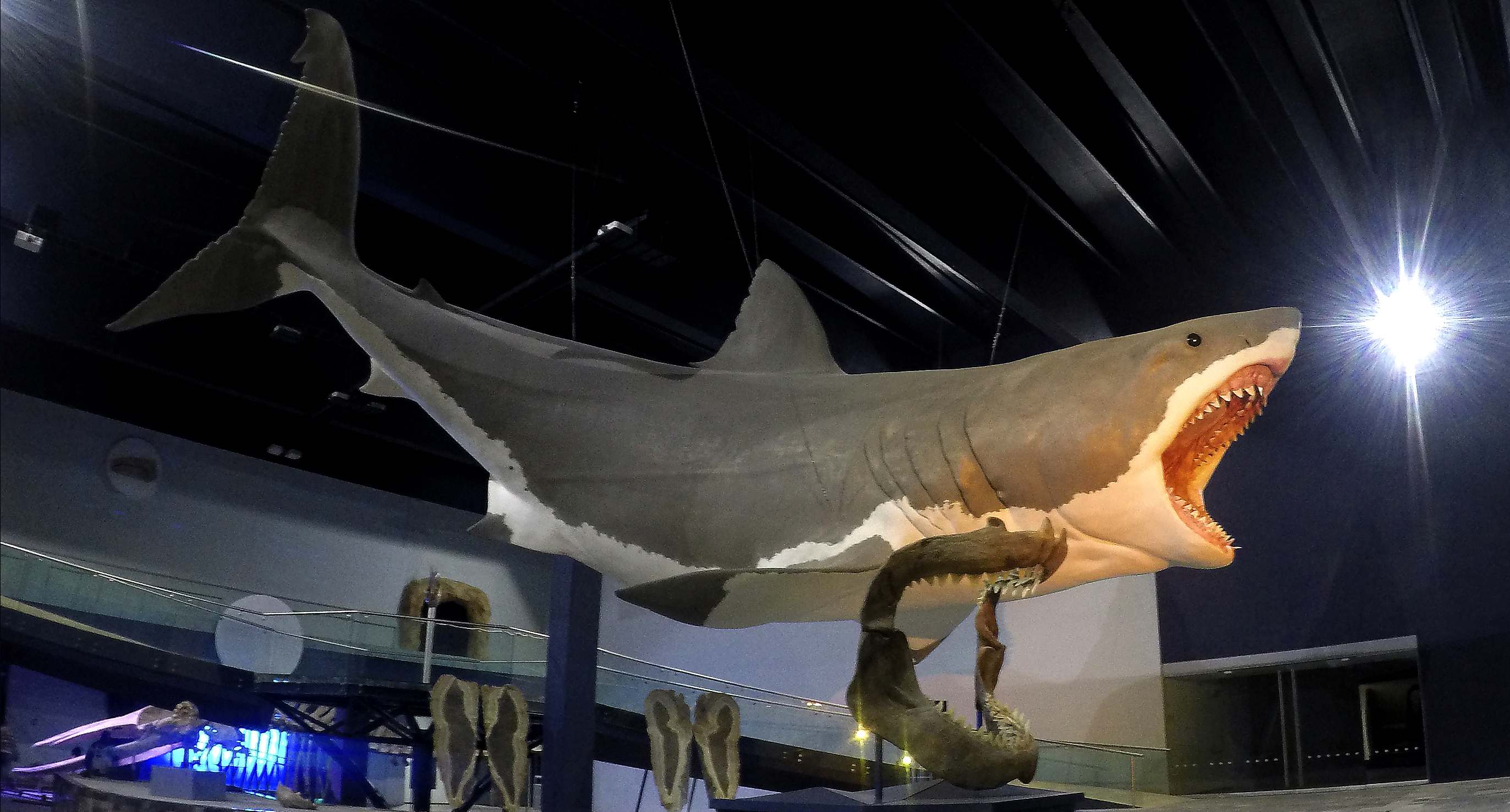
ART
- This superb sculpture is in the Museum of evolution, Pueblo, Mexico.
ABOUT
MEGALODON
Megalodon (Carcharocles megalodon), meaning "big tooth", is an extinct species of shark that lived approximately 23 to 2.6 million years ago (mya), during the Early Miocene to the end of the Pliocene. It was formerly thought to be a member of the Lamnidae family, making it closely related to the great white shark (Carcharodon carcharias). However presently there is near unanimous consensus that it belongs to the extinct family Otodontidae, which diverged from the ancestry of the great white shark during the Early Cretaceous. Its genus placement is still debated, authors placing it in either Carcharocles, Megaselachus, Otodus, or Procarcharodon.
Scientists suggest that megalodon looked like a stockier version of the great white shark, though it may have looked similar to the basking shark (Cetorhinus maximus) or the sand tiger
shark (Carcharias taurus). Regarded as one of the largest and most powerful predators to have ever lived, fossil remains of megalodon suggest that this giant shark reached a maximum length of 18 meters (59 ft) with the average size being 10.5 meters (34 ft). Their large
jaws could exert a bite force of up to 110,000 to 180,000 newtons (25,000 to 40,000 lbf). Their teeth were thick and robust, built for grabbing prey and breaking bone.
Megalodon probably had a major impact on the structure of marine communities. The fossil record indicates that it had a cosmopolitan distribution. It probably targeted large prey, such as whales, seals, and sea turtles. Juveniles inhabited warm coastal waters and fed on
fish and small whales. Unlike the great white, which attacks prey from the soft underside, megalodon probably used its strong jaws to break through the chest cavity and puncture the heart and lungs of its prey.
The animal faced competition from whale-eating cetaceans, such as Livyatan and other macroraptorial sperm whales, and smaller ancestral
killer whales such as Orcinus citoniensis. As the shark preferred warmer waters, it is thought that oceanic cooling associated with the onset of the ice ages, coupled with the lowering of sea levels and resulting loss of suitable nursery areas, may have also contributed to its decline. A reduction in the diversity of baleen whales and a shift in their distribution toward polar regions may have reduced megalodon's primary food source. The extinction of the shark appeared to affect other animals; for example, the size of baleen whales increased significantly after the shark had disappeared.
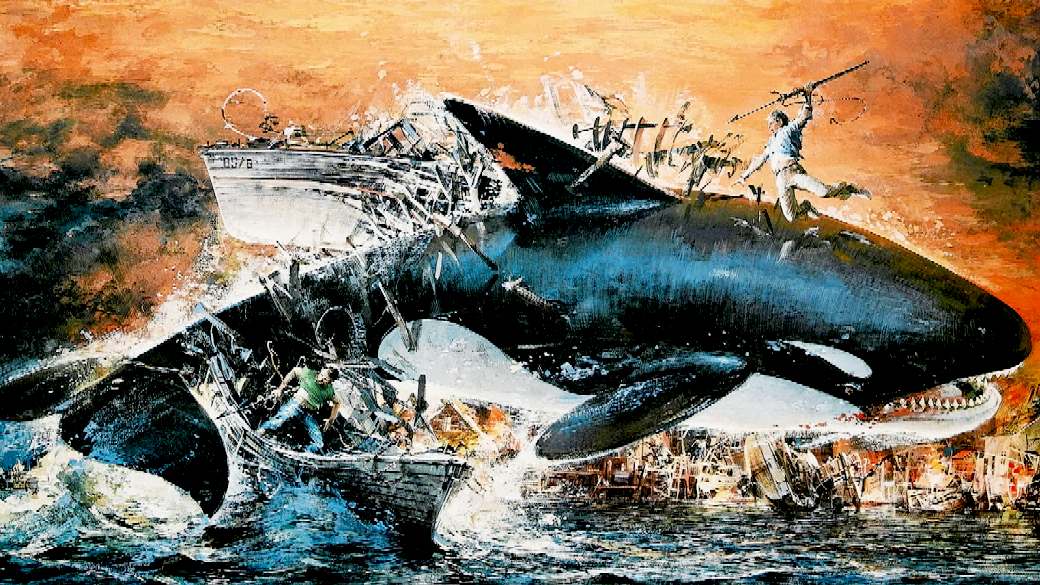
CLIMATE CHANGE & EXTINCTION
The Earth experienced a number of changes during the time period megalodon existed which affected marine life. A cooling trend starting in the Oligocene 35 mya ultimately led to glaciation at the poles. Geological events changed currents and precipitation; among these were the closure of the Central American Seaway and changes in the Tethys Ocean, contributing to the cooling of the oceans. The stalling of the Gulf Stream prevented nutrient-rich water from reaching major marine ecosystems, which may have negatively affected its food sources. The largest fluctuation of sea levels in the Cenozoic era occurred in the Plio-Pleistocene, between around 5 million to 12 thousand years ago, due to the expansion of glaciers at the poles, which negatively impacted coastal environments, and may have contributed to its extinction along with those of several other marine megafaunal species. These oceanographic changes, in particular the sea level drops, may have restricted many of the suitable shallow warm-water nursery sites for megalodon, hindering reproduction. Nursery areas are pivotal for the survival of many shark species, in part because they protect juveniles from predation.
As its range did not apparently extend into colder waters, megalodon may not have been able to retain a significant amount of metabolic heat, so its range was restricted to shrinking warmer waters. Fossil evidence confirms the absence of megalodon in regions around the world where water temperatures had significantly declined during the Pliocene. However, an analysis of the distribution of megalodon over time suggests that temperature change did not play a direct role in its extinction. Its distribution during the Miocene and Pliocene did not correlate with warming and cooling trends; while abundance and distribution declined during the Pliocene, megalodon did show a capacity to inhabit colder latitudes. It was found in locations with a mean temperature ranging from 12 to 27 °C (54 to 81 °F), with a total range of 1 to 33 °C (34 to 91 °F), indicating that the global extent of suitable habitat should not have been greatly affected by the temperature changes that occurred. This is consistent with evidence that it was a mesotherm.
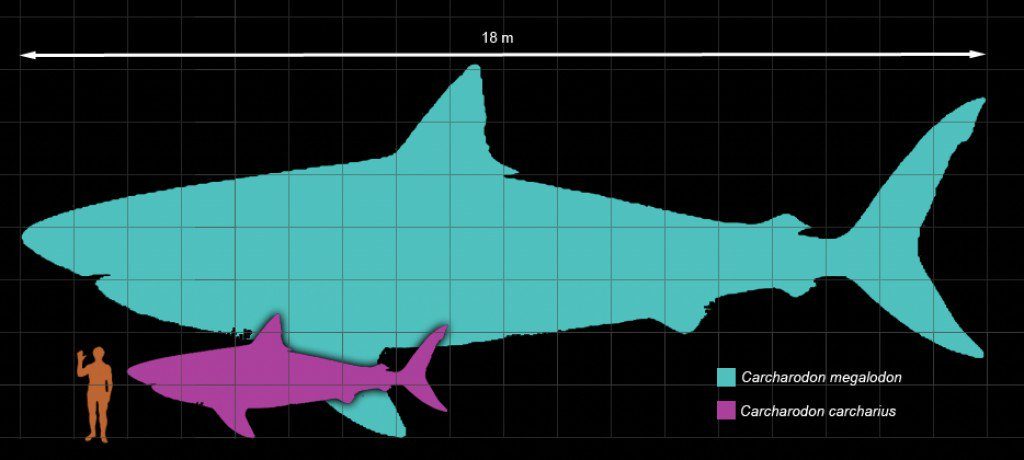
WHAT
WAS MEGALODON LIKE ?
The earliest megalodon fossils (Otodus megalodon, previously known as Carcharodon or Carcharocles megalodon) date to 20 million years ago. For the next 13 million years the enormous shark dominated the oceans until becoming extinct a mere 2.6 million years ago.
Megalodon was not only the biggest shark in the world, but one of the largest fish ever to exist. Estimates suggest it grew to between 15 and 18 meters in length, three times longer than the largest recorded great white shark.
Without a complete megalodon skeleton, these figures are based on the size of the animal's teeth, which can reach 18 centimetres long. In fact, the word megalodon simply means 'large tooth'. These teeth can tell us a lot, such as what these massive animals ate.
With its large serrated teeth megalodon would have eaten meat - most likely whales and large fish, and probably other sharks. If you are that big you need to eat a lot of food, so large prey is
required. This would have included animals as small as dolphins and as large as humpback whales.
We have other evidence of megalodon's feeding habits in the form of fossilised whale bones. Some of these have been found with the cut marks of megalodon teeth etched in the surface. Others even include the tips of teeth broken off in the bone during a feeding frenzy that occurred millions of years ago.
In order to tackle prey as large as whales, megalodon had to be able to open its mouth wide. It is estimated that its jaw would span 2.7 by 3.4 metres wide, easily big enough to swallow two adult people side-by-side.
These jaws were lined with 276 teeth, and studies reconstructing the shark's bite force suggest that it may have been one of the most powerful predators ever to have existed.
Humans have been measured with a bite force of around 1,317 Newtons (N), while great white sharks have been predicted to be able to bite down with a force of 18,216N. Researchers have estimated that megalodon had a bite of between 108,514 and 182,201N.
Megalodon likely had a much shorter nose, or rostrum, when compared with the great white, with a flatter, almost squashed jaw. Like the blue shark, it also had extra-long pectoral fins to support its weight and size.
A lot of reconstructions have megalodon looking like a bigger version of the great white shark because for a long time people thought they were related. We now know that this is not the case, and megalodon is actually from a different lineage of shark of which megalodon was the last
member.
The oldest definitive ancestor of megalodon is a 55-million-year-old shark known as Otodus obliquus, which grew to around 10 metres in length. But the evolutionary history of this shark is thought to stretch back to Cretalamna appendiculata, dating to 105 million years old - making the lineage of megalodon over 100 million years old.
As we've found more and more fossils, we've realised that the ancestor to the great white shark lived alongside megalodon. Some scientists think they might even have been in competition with each other.
Megalodon was adapted to warm tropical and subtropical locations around the globe. The species was so widely spread that megalodon teeth have been found on every continent except Antarctica.
We find lots of their teeth off the east coast of North America, along the coasts and at the bottom of saltwater creeks and rivers of North Carolina, South Carolina and Florida. This is likely due in part to the age of the rocks, but also because they can easily be found on the sea floor allowing collectors to go diving for them.
They are also quite common off the coast of Morocco and parts of Australia. They can even be found in the UK near Walton-on-the-Naze, Essex.
Sharks continually produce teeth throughout their entire lives. Depending on what they eat, sharks lose a set of teeth every one to two weeks, getting through up to 40,000 teeth in their lifetime. This means that shark teeth are continuously raining down onto the ocean floor, increasing the chance that they will get
fossilized.
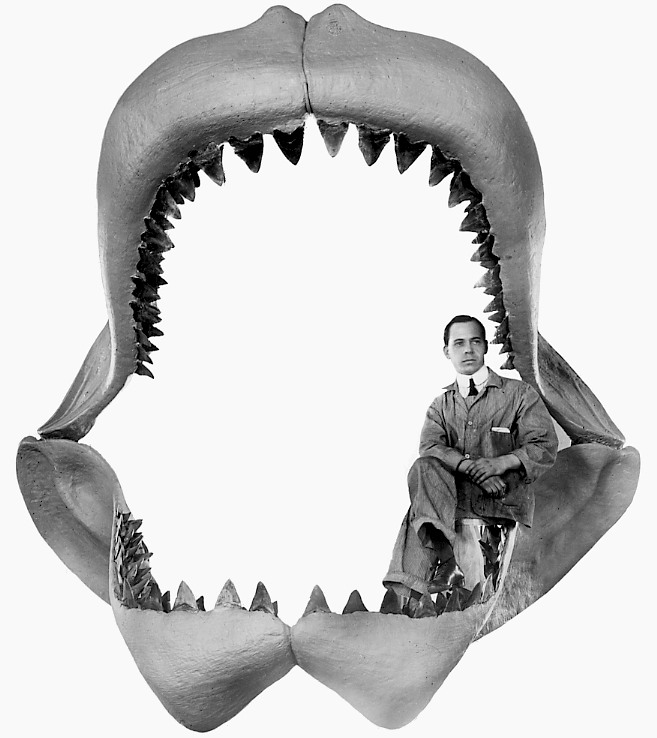
IS THE MEGALODON SHARK STILL ALIVE ?
The idea that megalodon might still be alive today is both terrifying and fascinating.
Even though most marine biologists and shark researchers tell us it's impossible, it's nevertheless interesting to wonder if and how a huge predatory shark could still exist somewhere in the vastness of the sea.
At a maximum length of up to 60 feet, Megalodon was the largest shark that ever lived, a wrecking machine of teeth and muscle that preyed on adult whales. It's hard to imagine there could still be a viable population of such creatures out there somewhere, living undetected.
Still, there are occasional reports of massive sharks thirty feet long or more from around the world. Are these real-life accounts of modern Megalodon
sightings. If not, what are these witnesses seeing? Is it possible mainstream science has it wrong, and is it still out
there.
This concept of a living Megalodon has spawned some interesting movies and novels, not to mention caught the attention of shark enthusiasts, both amateur and professional. Even the Discovery Channel featured a special on the Megalodon for Shark Week 2012, complete with a massive recreation of the monster.
The next year they went on to offer an even more artificial rendition of the creature, leading to the Shark Week 2013 fiasco. The docudrama called Megalodon: The Monster Shark Lives ignited a world-wide interest, largely because so many people believed the footage and actors in the film were real.
For Shark Week 2014, the Discovery Channel tried again with a rehashed version of Megalodon Lives. However, the public had caught on by this point, and the same people who were blown away a year earlier were now bent on finding facts.
Much like the modern Great White, Megalodon was probably an ambush predator that took its prey by surprise, either from below or by approaching at great speeds. This would have meant it was a very active shark, not some lumbering giant like the Whale Shark. It was a coastal shark, hunting offshore. Again, like our modern Great White.
Megalodon would have been found in just about every ocean of the world, preying on whales, dolphins and other marine mammals, and even giant sea turtles. In short, it would have eaten just about anything it wanted. If it were really around, it would not be hard to spot.
If still alive today, it’s easy to see that all of the above can no longer be true. A massive, 60-foot shark hunting whales close to shore would surely be well-known, not to mention widely feared. So if Meg is still around, it must have changed its behaviors drastically.
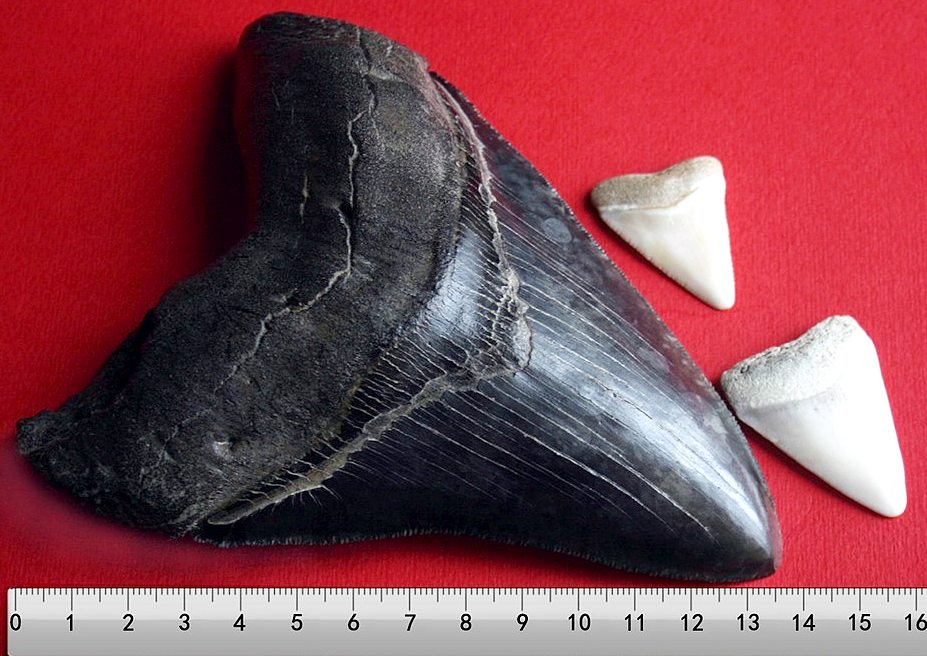
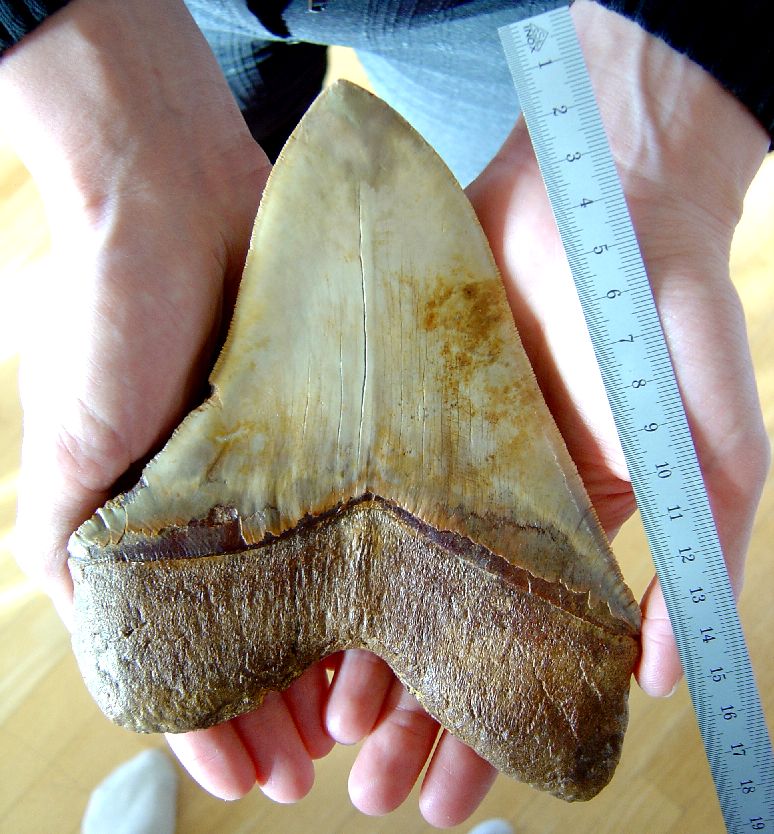
THE MARIANA TRENCH
With interests in science, nature, and the paranormal, cryptid explores fringe topics from a unique and sometimes controversial perspective.
Alleged Megalodon shark sightings over the years have led to the legend of a massive, prehistoric shark that still patrols the oceans of our
world - a bit like King Kong. Carcharodon Megalodon was once a real shark — the most formidable predator the world has ever seen — but modern science claims it went extinct long ago. The idea that it might still be alive today is both terrifying and fascinating.
Even though most marine biologists and shark researchers tell us it's impossible, it's nevertheless interesting to wonder if and how a huge predatory shark could still exist somewhere in the vastness of the sea.
At a maximum length of up to 60 feet, Megalodon was the largest shark that ever lived, a wrecking machine of teeth and muscle that preyed on adult whales. It's hard to imagine there could still be a viable population of such creatures out there somewhere, living undetected.
Still, there are occasional reports of massive sharks thirty feet long or more from around the world. Are these real-life accounts of modern Megalodon sightings? If not, what are these witnesses seeing? Is it possible mainstream science has it wrong, and is it still out there?
In this article we'll take a look at some compelling evidence and stories that suggest Megalodon is still with us. Some say it could still exist in deep and largely unexplored areas of the ocean such as the Mariana Trench. In the end, it's up to you to decide: Is there enough proof to support the idea that the Megalodon shark is still
alive.
So, when we talk about Megalodon we are looking at it from two different points of view: Paleontology and Cryptozoology. It is important to distinguish the difference.
The shark of paleontology can be studied by looking at the fossil record and living sharks in order to puzzle out what the real Megalodon may have been like. From a paleontology perspective, this shark is officially extinct, but that doesn’t make it any less interesting.
The idea of a living Megalodon is a stance taken by cryptozoologists, and it is not supported by mainstream science. Why would anybody think this is possible? That is the question examined in this article, and later we will get into how and why people think Meg could still be around.
We know of the real Megalodon shark only from fossil records and preserved teeth. Because shark skeletons consist mostly of cartilage, these are the only parts that fossilize. No living or dead specimen has ever been recovered in modern times. Also, there are no "official" sightings on record.
So what makes us think it could still be around. More importantly, has anything like this ever happened before?
In fact, there is precedence for bizarre marine creatures turning up when the odds are stacked against them. Some of them, like the Megalodon shark, were once thought extinct, or believed to only be myths.
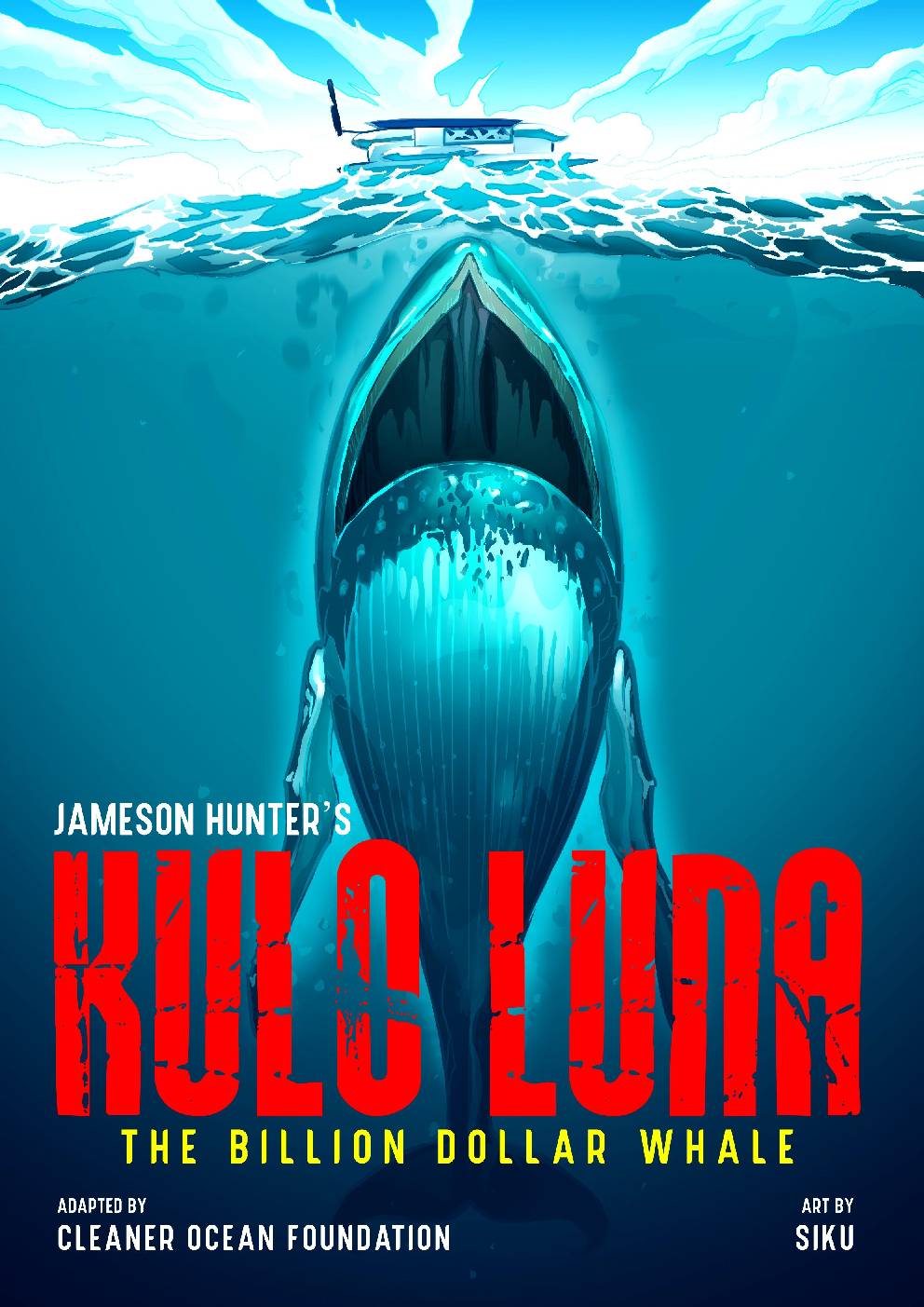
Historic Megalodon Sightings and Evidence
There are a handful of well-documented pieces of evidence and testimony that suggest Megalodon is still alive. Here are a few of the more well-known stories:
Huge Teeth Found by HMS Challenger: In 1875, two Megalodon teeth were dredged up during a deep-sea expedition by the HMS Challenger, dated only 10,000 - 15,000 years old. If the methods used were accurate, this would mean it went extinct much more recently than previously believed, and make it a contemporary of modern humans. Ten thousand years is only a blink of an eye in the world of paleontology. It does not take a great imagination to think the Megalodon shark may have survived the past 10,000 years undetected in the depths of the oceans.
Fishermen Terrified by Giant Shark: In 1918 an Australian naturalist named David Stead recorded events when local fisherman refused to go back out to sea after an unbelievably massive shark had demolished their gear and taken their catch. These were experienced men of the sea, familiar with whales and large sharks, but whatever they had seen had frightened them so much that they refused to work. According to Stead, they described it as between 35 and 90 meters long and pure white in color. These proportions seem unbelievable. Could a shark really grow to that size? Were these men exaggerating? Or, were they just confused?
Massive Shark Threatens 55-Foot Fishing Boat: In the 1960s, the captain of a 55-foot
fishing ship reported that a white shark at least as long as the boat passed by while they sat at anchor. The crew refused to officially discuss the sighting, but the Captain gave his account. An experienced sailor, the Captain would have been able to recognize a whale if that is what it had been, but he claimed it was indeed a giant shark. Are stories such as this one based on real encounters, or are they just products of the imaginations of sailors who have been at sea too long?
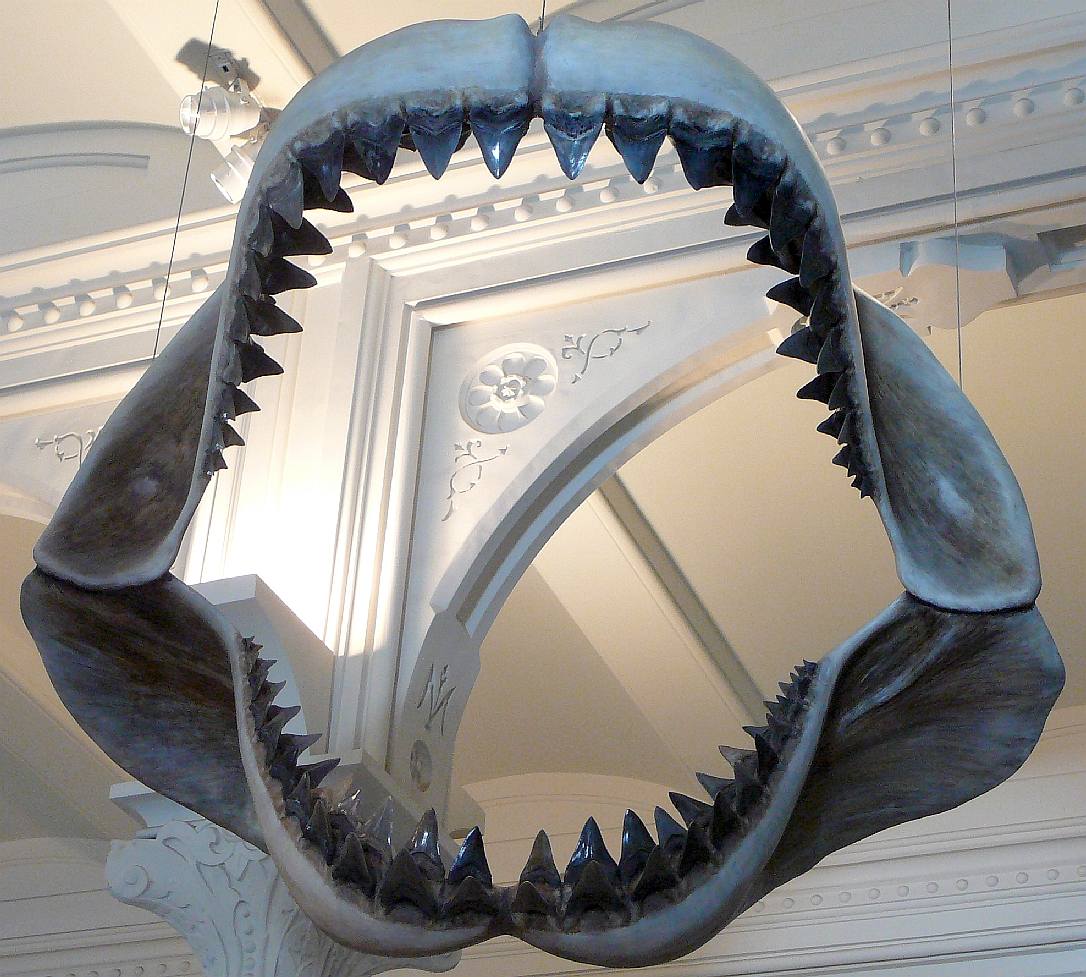
Recent Sightings and Anecdotal Evidence
Unfortunately, when it comes to more recent sightings, the casual researcher has to weed through a whole bunch of nonsense to get to any stories with credibility. YouTube is awash with clips of supposed Megalodon encounters —
unfortunately, all fake.
Megalodon has firmly planted itself in the realm of cryptozoology, and few marine biologists and shark researchers take the creature seriously in the modern day. Occasionally a stray report will wash up of a larger-than-normal shark spotted somewhere. But, given that Great Whites can theoretically grow in excess of 20 feet, it’s certainly possible that these are misidentified animals. Most marine biologists would be thrilled enough to discover a 20-foot Great White!
But there are at least a few interesting tidbits for consideration:
Megalodon Monsterquest Episode: Back in 2009, the History Channel show Monsterquest visited the Sea of Cortez where massive sharks have been reported for years. These beasts are allegedly three times larger than the biggest Great White sharks in the area, and known for decimating the local marine mammal populations. The Monsterquest team failed to find Megalodon, but many still believe that if this giant shark is still around, this would be a prime location for finding it.
The Monster of Bird Island: In 2012, on an episode of the show Shark Wranglers called Monster of Bird Island, shark researchers interviewed a group of South African fisherman who claimed there was a huge shark in the area as big as their boat. The boat appeared to be thirty or forty feet long. Was this a Megalodon shark these fisherman had witnessed? Later in the episode, one of the researchers told a tale of a 30-foot shark he had seen when he was younger.
The Discovery Channel and Megalodon Lives
This concept of a living Megalodon has spawned some interesting movies and novels, not to mention caught the attention of shark enthusiasts, both amateur and professional. Even the Discovery Channel featured a special on the Megalodon for Shark Week 2012, complete with a massive recreation of the monster.
The next year they went on to offer an even more artificial rendition of the creature, leading to the Shark Week 2013 fiasco. The docudrama called Megalodon: The Monster Shark Lives ignited a world-wide interest, largely because so many people believed the footage and actors in the film were real.
For Shark Week 2014, the Discovery Channel tried again with a rehashed version of Megalodon Lives. However, the public had caught on by this point, and the same people who were blown away a year earlier were now bent on finding facts.
That's good. This is a creature worth exploring, and whether or not it still survives today it is one of the most fascinating real-world monsters that ever lived.
What was Megalodon Really Like?
Though we think of the Megalodon as a giant Great White Shark, many researchers believe it may not have resembled one at all. Indeed, some say they were not even closely related.
Did it act like a Great White? Most researchers say it was probably similar, but of course there is no way to be sure. So when someone spots a giant Great White Shark, what are the odds it could really be a relic Megalodon?
From this perspective, there could be countless undocumented sightings throughout history.
So what was Megalodon shark really like?
Like the Great White, Megalodon had serrated teeth. While we think of modern sharks as formidable predators we surely wouldn't want to cross paths with, the Megalodon would have been in a whole new class of terror. Even after countless centuries, some fossilized Megalodon teeth are still sharp to the touch. We can only imagine what they were capable doing to a large prey item like a whale, let alone a human.
The largest teeth can be seven inches long — the size of a grown-man's hand. It was the largest and most highly evolved in a lineage of megatoothed sharks.
Though they look like larger versions of Great White Shark teeth, paleontologists point to slight differences in the Megalodon teeth and its ancestors as proof that the Megalodon shark is not closely related to the Great White. This would put it in the genus Carcharocles rather than the Great White's Carcharodon. This is a matter still up for debate.
With jaws like this the Megalodon Shark would have made short work of anything in the ocean, including whales and giant sea turtles.
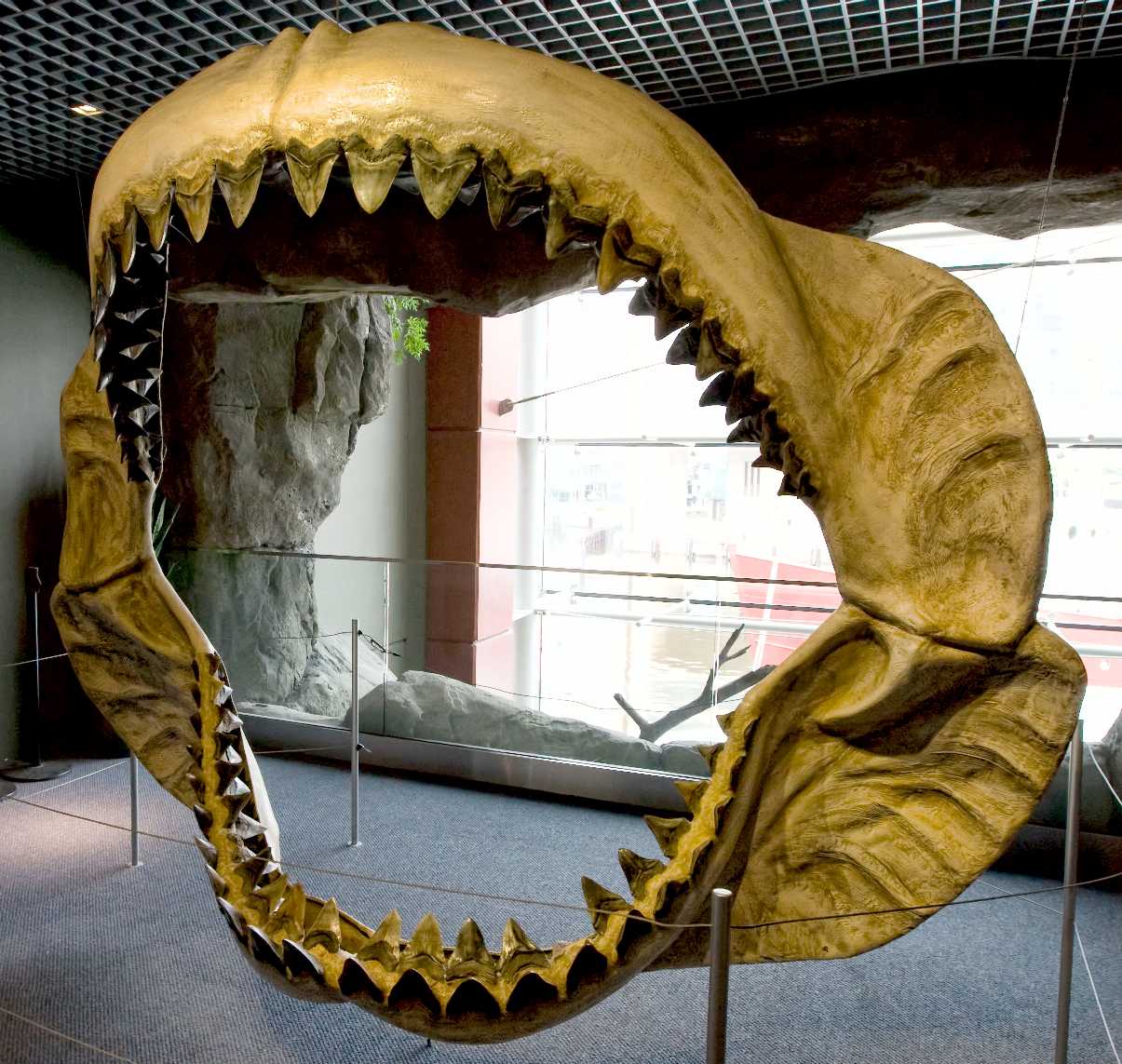
A Powerful Bite Force
Regardless of its heritage, this shark had a set of chompers never seen in the animal kingdom before or since. Researchers have calculated that this massive shark may have had a bite force of 18 tons! A T-Rex had a bite force of only one-third that. The strongest biter in our world today is the saltwater crocodile, and they only come in around 3700 pounds.
It's clear that the teeth and jaws were made for destruction. Interestingly, some researchers say it may have bitten off the fins of its prey before finishing it off. That makes the Megalodon tooth arsenal not only powerful, but capable of a certain amount of precision as well.
Behavior and Hunting Technique
Much like the modern Great White, Megalodon was probably an ambush predator that took its prey by surprise, either from below or by approaching at great speeds. This would have meant it was a very active shark, not some lumbering giant like the
Whale Shark. It was a coastal shark, hunting offshore. Again, like our modern Great White.
Megalodon would have been found in just about every ocean of the world, preying on whales, dolphins and other marine mammals, and even giant sea turtles. In short, it would have eaten just about anything it wanted. If it were really around, it would not be hard to spot.
If still alive today, it’s easy to see that all of the above can no longer be true. A massive, 60-foot shark hunting whales close to shore would surely be well-known, not to mention widely feared. So if Meg is still around, it must have changed its behaviors drastically.
Check out the video of Great White sharks hunting below and imagine the Megalodon preying on massive whales in the same manner! It must have been amazing!
Megalodon Nurseries
Scientists think that the Megalodon young lived in shark nurseries like Great Whites do. These are areas, usually close to shore, where young sharks can grow and feed in relative safety. Megalodon young may have started out eating fish or other small prey items, and then moved on to larger prey as they got bigger.
So where are the baby sharks? They may be living at great depths like their parents, or it could be possible that they they are so rare and so similar to the Great White that when they are spotted they are simply assumed to be adult Great White sharks.
The Livyatan Whale: A Formidable Rival?
It's pretty clear that the Megalodon Shark was the most powerful beast in the ancient Miocene ocean, but could there have been another creature just as fearsome that gave Meg a run for its money?
The recently discovered Livyatan whale was as big as Megalodon, with teeth over a foot long. It competed with Megalodon for food, but what happened when these two prehistoric heavyweights met face to face?
Like modern whales, Livyatan was likely highly intelligent, and may have even hunted in pods. On the other hand, Megalodon never needed to come up for air, and had the element of surprise on its side. Meg also preyed on whales for food, and we can imagine it took down at least juvenile
Livyatans.
How Did Megalodon
Become Extinct?
If this shark was such a ferocious predator, why did it die out? Unfortunately, even the strongest creatures are no match for Mother Nature. While Meg inhabited every ocean of the world, the planet was a much warmer place back then.
As the environment entered a cooling period, sea levels began to fall and currents shifted, causing not only a cooling of the ocean itself, but also a shift in the food supply. Theoretically, the Megalodon shark either couldn’t adapt to the colder climate, the food issues, or both.
There is also evidence that the situation may have been complicated by the evolution of other large, predatory marine creatures which may have infringed on Megalodon’s niche. The rise of species such as Orca (the killer whale) may have speeded Meg's extinction.
Does Megalodon Live in the Mariana Trench?
For Meg to still be still alive, it would have had to adapt to colder temperatures, a different breeding pattern, and greatly different food sources. Some speculate that Megalodon populations may have survived in the Mariana Trench and other deep parts of the ocean.
Certainly we know that whales and giant squids venture very deep, so it is conceivable that Megalodon would have the food it requires. In fact, recent research on Great White sharks shows they may dive fairly deep in search of food. If Meg followed similar habits, perhaps it could have made the adaptations to deep-ocean life much easier than some experts suggest.
Unfortunately, the larger an animal is, and the more specific its niche in the environment, the harder a time it has in adapting to environmental changes. It's unlikely that the vast majority of these sharks would have been able to adapt to a major shortage in their food supply. An animal that evolved to feed on large marine mammals would have a tough time switching to oceanic fish, for example.
However, what is conceivable is that a small population which had already made some adaptations to a different food sources and lifestyle (such as diving to great depths and feeding on squid) could have survived the die-off and maintained a small, remnant population over the centuries.
Mainstream science is unmoved by the evidence supporting the possibility of Megalodon’s existence today. Still, the idea of this monster shark out there patrolling the ocean deep is fascinating to imagine. There is still so much of the ocean left unexplored, the possibilities are almost endless.
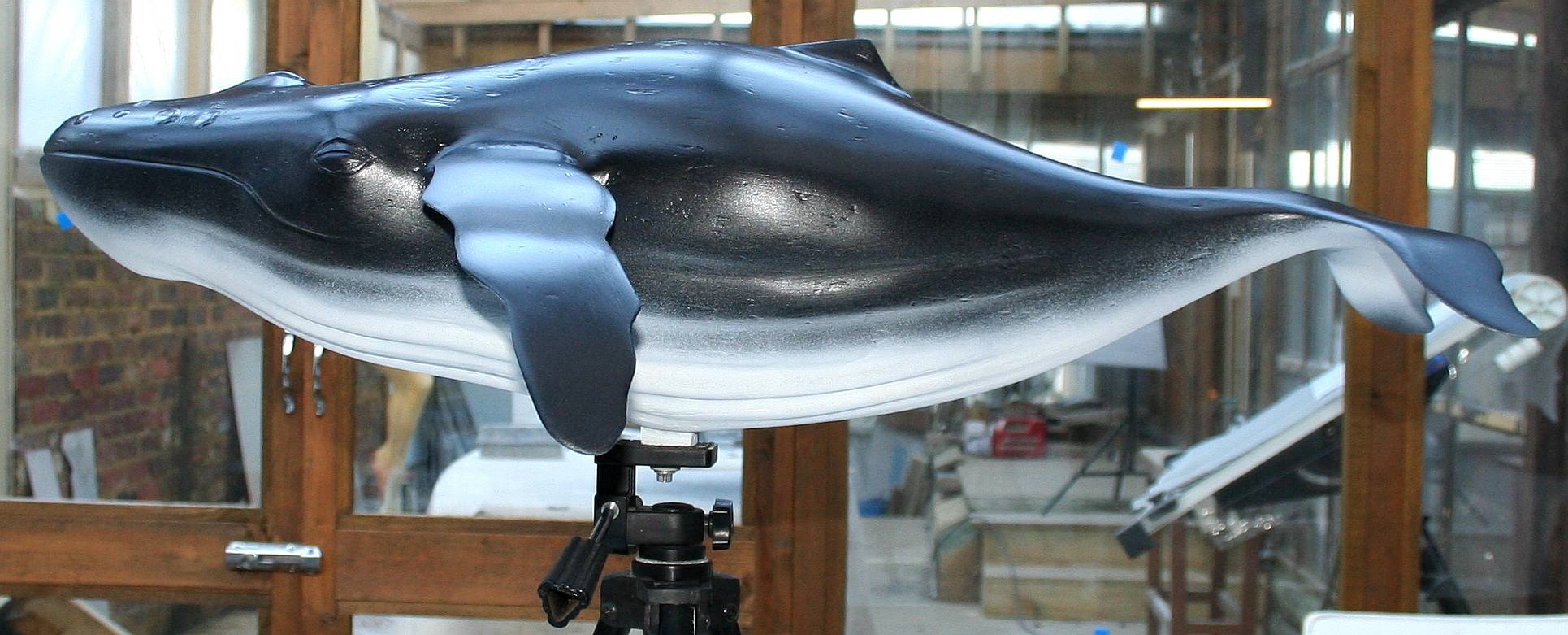
HUMPBACK
- This is a 1/20th scale model of Kulo Luna, a humpback whale for use in
displays with the SeaVax
and Elizabeth
Swan tank test models. She is made of fibreglass, 760mm (30")
long and will float in water at the correct displacement. Seen here in a
basecoat for final grey and white primer coats before detailing. The
skills needed to make such models quickly might be needed for larger
exhibits in connection with the Cleaner Ocean Foundation's awareness
campaigns. Imagine a full size humpback whale. Most of our models are fitted to revolving displays where the stand is
motorised. This humpback whale model is fixed to a modified camera tripod
for static showing. The detailing of this artwork is to follow the Refill
event in Eastbourne on January the 26th 2019. Copyright © Jameson
Hunter December 24 2018.
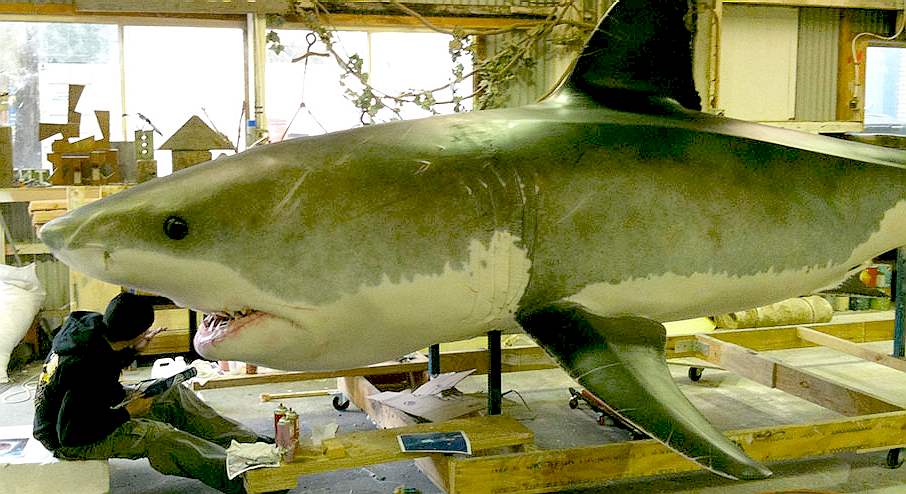
ABSOLUTELY
BRILLIANT - Sea Life Sydney Aquarium (formerly Sydney Aquarium) is a public aquarium located in the city of Sydney, New South Wales, Australia. It is located on the eastern (city) side of Darling Harbour to the north of the Pyrmont Bridge. It is a full institutional member of the Zoo and Aquarium Association (ZAA) and the World Association of Zoos and Aquariums
(WAZA). If you take the time to visit this display, we think you may agree
that the artwork is first rate, in fact one of the best around.
POPULAR CULTURE
Megalodon has been portrayed in several works of fiction, including films and novels, and continues to be a popular subject for fiction involving sea monsters. Three individual megalodon, two adults and one juvenile, were portrayed in BBC's 2003 TV series Sea Monsters, where it is defined as a "hazard" of the era. The History Channel's Jurassic Fight Club portrays a megalodon attacking a Brygmophyseter sperm whale in Japan. Several films depict megalodon, such as Shark Attack 3: Megalodon and the Mega Shark series (for instance Mega Shark Versus Giant Octopus and Mega Shark Versus Crocosaurus). The shark appears in the 2017 videogame Ark: Survival Evolved. Some stories, such as Jim Shepard's Tedford and the Megalodon, portray a rediscovery of the shark. Steve Alten's Meg: A Novel of Deep Terror portrays the shark having preyed on dinosaurs with its prologue and cover artwork depicting megalodon killing a Tyrannosaurus in the sea. The sequels to the book also star megalodon: The Trench, Meg: Primal Waters, Meg: Hell's Aquarium, and Meg: Origins, and there is a film adaptation entitled The Meg released on August 10, 2018.
Animal Planet's pseudo-documentary Mermaids: The Body Found included an encounter 1.6 mya between a pod of mermaids and a megalodon. Later, in August 2013, the Discovery Channel opened its annual Shark Week series with another film for television, Megalodon: The Monster Shark Lives, a controversial docufiction about the creature that presented alleged evidence in order to suggest that megalodon was still alive. This program received criticism for being completely fictional; for example, all of the supposed scientists depicted were paid actors. In 2014, Discovery re-aired The Monster Shark Lives, along with a new one-hour program, Megalodon: The New Evidence, and an additional fictionalized program entitled Shark of Darkness: Wrath of
Submarine, resulting in further backlash from media sources and the scientific community.
Reports of supposedly fresh megalodon teeth, such as those made by HMS Challenger in 1873 which were erroneously dated to be around 11,000 to 24,000 years old, are probably teeth that were well-preserved by a thick mineral-crust precipitate of manganese dioxide, and so had a lower decomposition rate and retained a white color during fossilization. Fossil megalodon teeth can vary in color from off-white to dark browns and greys, and some fossil teeth may have been redeposited into a younger stratum. The claims that megalodon could remain elusive in the depths, similar to the megamouth shark which was discovered in 1976, are unlikely as the shark lived in warm coastal waters and probably could not survive in the cold and nutrient-poor deep sea environment.
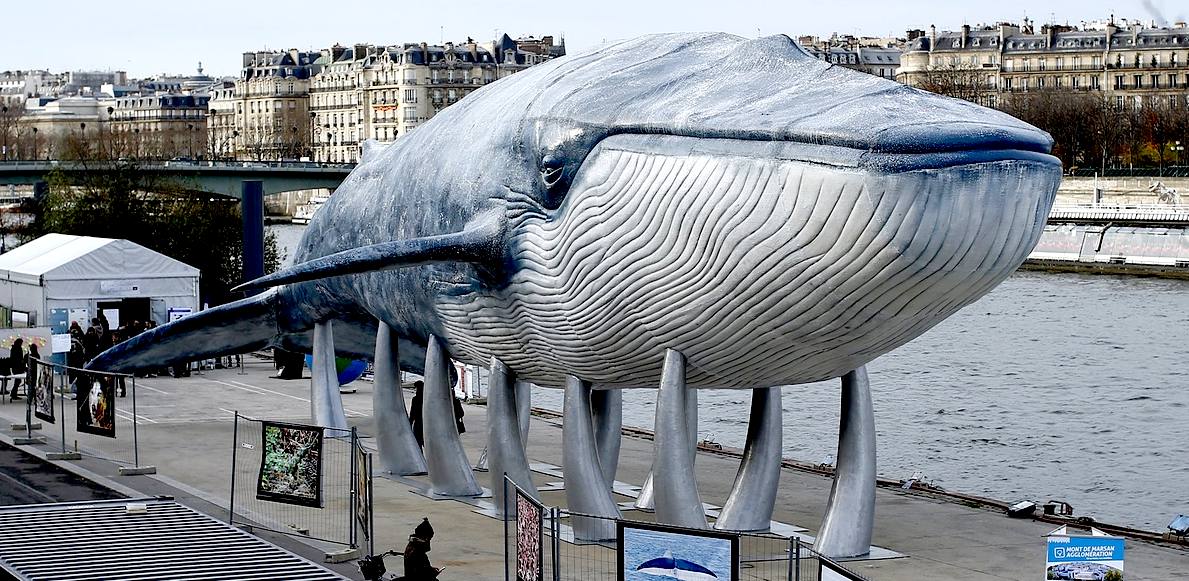
BLUE
WHALE - A magnificent display in Paris
on the banks of the River Seine for the climate talks in December 2015,
this is the giant metal sculpture of 'Bluebelle,' a whale caught in the South Atlantic
Ocean in 1912.
Additional
inspiration came from the above display on the banks of the River
Seine, though not a marine animatronic, it is crying out to be one.
LINKS
& REFERENCE
https://www.livescience.com/63361-megalodon-facts.html
https://exemplore.com/cryptids/Is-the-Megalodon-Shark-Still-Alive
http://www.nhm.ac.uk/discover/megalodon--the-truth-about-the-largest-shark-that-ever-lived.html
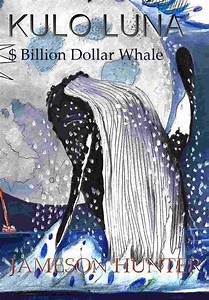
KULO
LUNA:
A
heartwarming adventure: pirate whalers
V a wounded whale and three kind people out to save the cetacean, with
a $Billion dollars riding on the conclusion.
ACIDIFICATION
- ADRIATIC
- ARCTIC
- ATLANTIC - BALTIC
- BAY BENGAL - BERING
- CARIBBEAN - CORAL - EAST
CHINA
ENGLISH CH
-
GOC - GULF
GUINEA - GULF
MEXICO
- INDIAN
-
IRC - MEDITERRANEAN -
NORTH SEA - PACIFIC
- PERSIAN GULF - SEA
JAPAN
STH
CHINA - PLASTIC
- PLANKTON - PLASTIC
OCEANS - SEA
LEVEL RISE - UNCLOS
- UNEP
WOC
- WWF
AMAZON
- BURIGANGA - CITARUM - CONGO - CUYAHOGA
-
GANGES - IRTYSH
- JORDAN - LENA -
MANTANZA-RIACHUELO
MARILAO
- MEKONG - MISSISSIPPI - NIGER - NILE - PARANA - PASIG - SARNO - THAMES
- YANGTZE - YAMUNA - YELLOW
DINOSAURS
- DOLPHINS
- HUMANOIDS
- RAYS
- SHARKS
- WHALES
|













